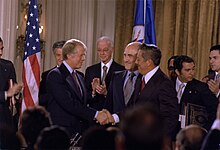Hay-Bunau-Varilla contract
The Hay-Bunau-Varilla Treaty was a state treaty signed in Washington, DC on November 18, 1903, two weeks after Panama gained independence from Colombia . He gave the United States ownership of the Panama Canal .
Philippe Bunau-Varilla was French and, as Panamanian Envoy Extraordinary and Minister Plenipotentiary, traveled to the US capital and New York City to negotiate terms with various US officials, the most prominent representative of which was Secretary of State John Hay . The two men negotiated the terms of sale for the canal structure and a Panama Canal zone to surround the canal. No Panamanian signed the treaty, although Bunau-Varilla was present as Panamanian minister - but with French citizenship .
Bunau-Varilla was originally involved in the construction of the Panama Canal under the same man who built the Suez Canal : Ferdinand de Lesseps . After de Lessep's efforts to build the Panama Canal and the collapse of these efforts in the spectacular Panama Scandal , Bunau-Varilla became a major shareholder in the successor company Compagnie Nouvelle du Canal de Panama , which now had both the concession and certain assets for the canal construction in Panama decreed. As part of the Hay-Bunau-Varilla negotiations, the United States bought the shares and assets of the Compagnie Nouvelle du Canal de Panama for 40 million US dollars .
The Hay-Bunau-Varilla Treaty was also called The Treaty No Panamanian Signed , although Panama later agreed to the terms, including maintaining the United States' permanent rights in a five- mile width on either side of the sea route Canal zone. After ratification, Panama would receive a payment of US $ 10 million in gold (the equivalent of around US $ 299 million today) for this treaty and, starting nine years later, annual rent payments of US $ 250,000.
On February 26, 1904, after the ratification process in both states, the treaty was promulgated in Washington. The most important contract points included:
- the neutrality of the Panama Canal,
- the equality of use for all flags, both American and other,
- the payment of $ 10 million to Panama, originally intended for Colombia,
- the protection of Panama against any attack.
The treaty has been a source of conflict between Panama and the United States from the start, culminating in turmoil over US sovereignty in the Panama Canal Zone on January 9-11, 1964 . When a Panamanian flag was torn during the conflict between Panamanian students and police officers in the Canal Zone, widespread riot began over the right to fly the Panamanian flag next to the stars and stripes. US Army units were brought in to quell violence in the flag battle after the Canal Zone police were overwhelmed. 23 Panamanians and four US soldiers were killed in the three-day fighting. The 9th of January was therefore known in Panama as Día de los Mártires or Martyrs' Day ( Day of the Martyrs ).
These events are seen as a major factor in the U.S. decision to negotiate the Torrijos-Carter Treaties in 1977 , which eventually abolished the Hay-Bunau-Varilla Treaty and the gradual transfer of control of the Canal Zone to Panama and the handover of all Rights granted over the Panama Canal on December 31, 1999. This agreement was concluded for the Central American state by General Omar Torrijos, who came to power in a coup in 1968, and US President Jimmy Carter as his contractual partner .
See also
literature
- Gustavo A. Mellander, Nelly Maldonado Mellander: Charles Edward Magoon. The Panama Years. Editorial Plaza Mayor, San Juan - Puerto Rico 1999, ISBN 1-563-28155-4 .
- Gustavo A. Mellander: The United States in Panamanian Politics. The Intriguing Formative Years. The Interstate Printers & Publishers, Danville IL 1971, OCLC 138568.


